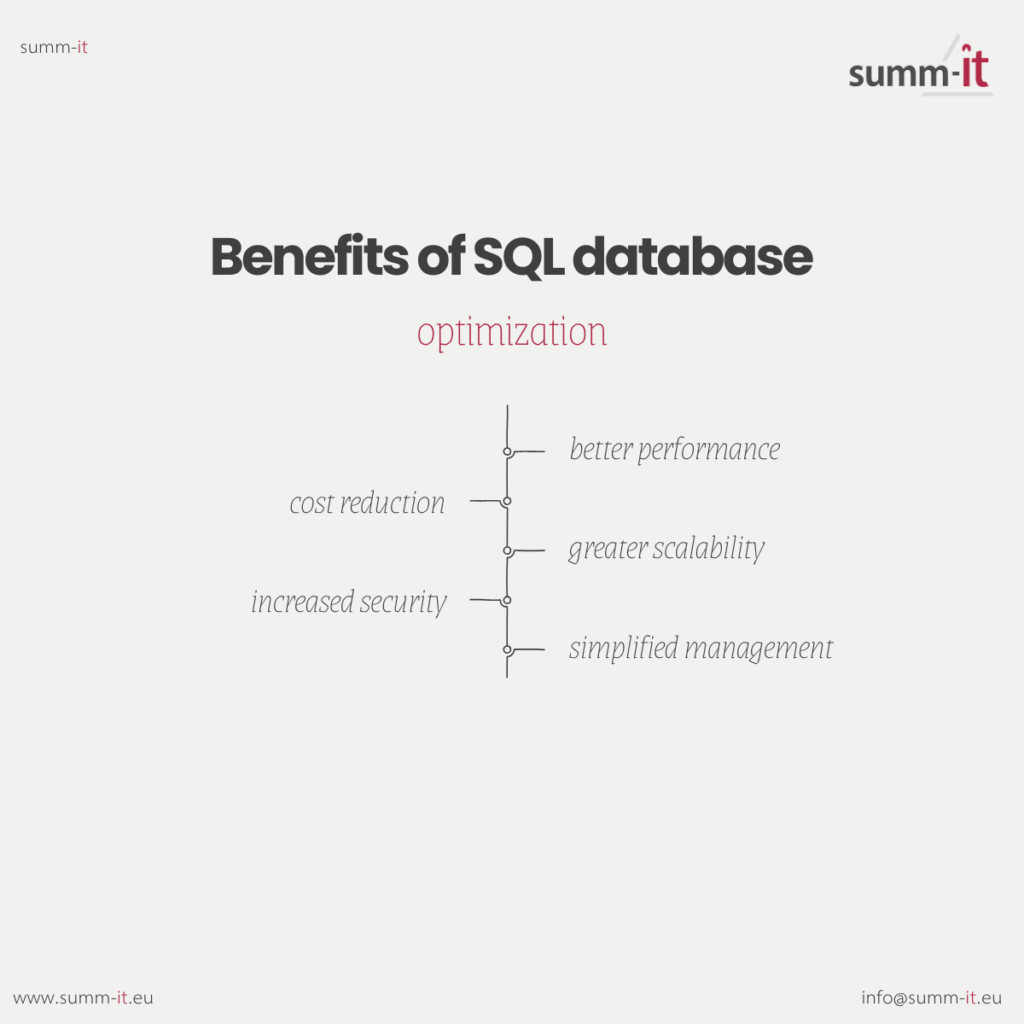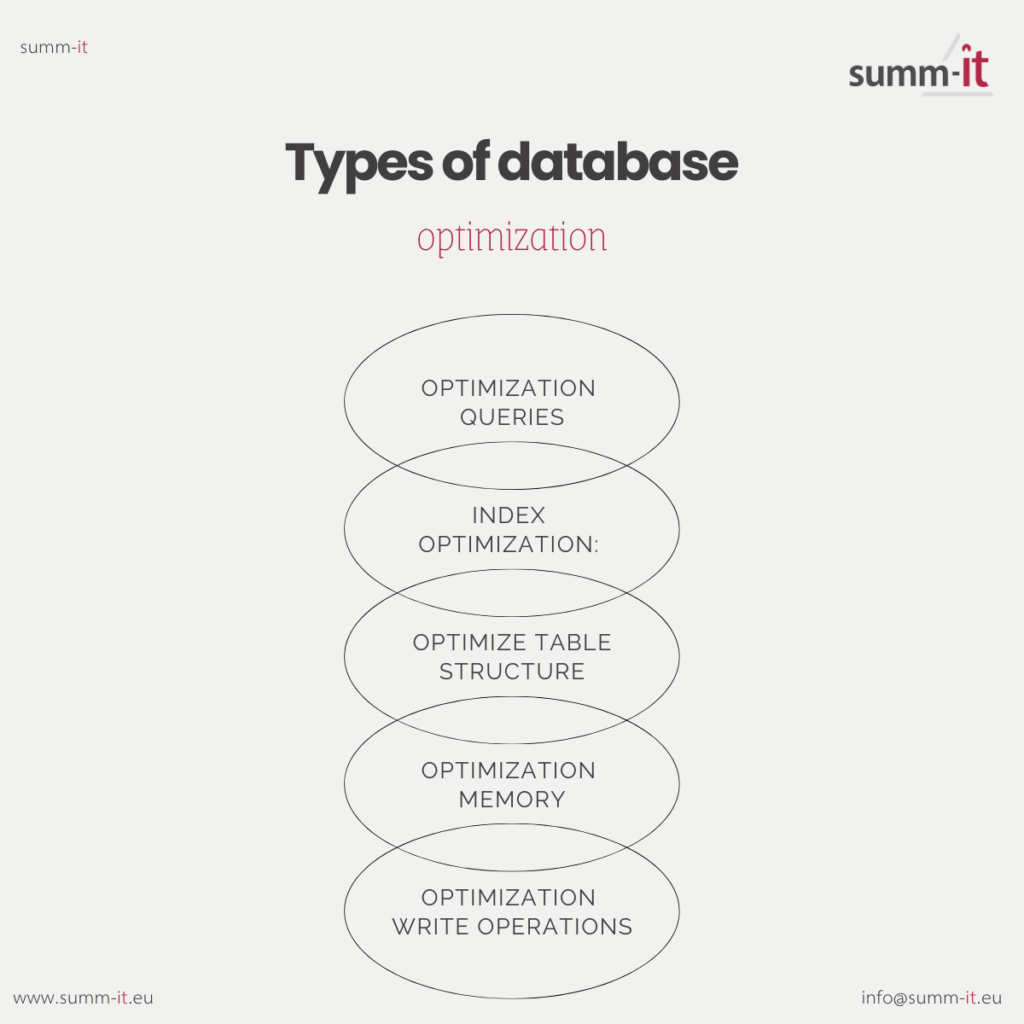A database is an electronic collection of information that can be more or less organized. Most of the data is stored in the SQL language, which is also used to handle queries. A database management system controls the entire database. Optimization is advisable when the database does not respond to the requested operations, generates errors or does not allow the query to be processed.
If this applies to your company’s database or your goal is to increase the performance and efficiency of your application, then you should be interested in the topic of database system optimization.
Therefore, we have prepared a short guide that will help you understand how to effectively optimize a SQL database, what the whole process of such optimization looks like. You will also learn the best practices to get the most out of your database.
Whether you’re already an experienced administrator or just starting out on your adventure with
with databases – you will get valuable tips here, which in a way will make your work easier and, following this, improve the performance of your system.
Understanding SQL database optimization
In order to successfully perform SQL database optimization, it is essential to understand how the database works and the factors that affect its performance. In this section, we will consider basic concepts related to optimization, such as indexing, normalization, and denormalization. We will reveal the most common database performance problems and suggest how to deal with them. This will help you get the most out of your database.
Definition of SQL database optimization
SQL database optimization is a process that involves improving the performance and efficiency of a database. This means that we try to make database queries execute faster and consume fewer resources, such as memory and CPU. Optimization can involve various activities, such as creating indexes, improving the structure of tables, or optimizing SQL queries.
Benefits of SQL database optimization
Optymalizacja bazy danych SQL oferuje wiele korzyści, które mogą znacząco poprawić wydajność
i efektywność systemów informatycznych. Oto kilka kluczowych zalet:

- Improved performance: Improved execution of SQ queries leads to faster data access and faster application response times.
- Cost reduction: Efficient management of server resources can reduce costs associated with associated with IT infrastructure, including memory and CPU usage.
- Increased scalability: Enabling the database to expand more easily as data volumes and user numbers increase, without sacrificing performance.
- Enhanced security: Optimization can also include strengthening security mechanisms, which protects data from unauthorized access.
- Simplified management: Reduce administrative complexity with better data organization and more efficient management procedures.
Common scenarios that require optimization
SQL database optimization is crucial in many cases – situations that can affect the performance and functionality of systems. Here are some common situations where optimization is essential:
- Growing number of users: When a database begins to support an increasing number of users, it can lead to a drop in performance. Optimization helps keep response times fast and applications running smoothly.
- Increasing data volume: As the database grows, queries can become slower. Optimizing the structure of tables and indexes can significantly improve query execution times.
- Complicated queries: Complex SQL queries that combine multiple tables or contain nested subqueries can be very time-consuming. Optimizing these queries can speed up their execution.
- Frequent write operations: In systems where frequent write operations such as inserting, updating or deleting data occur, optimization can help manage locks and improve performance.
- Performance problems: If users report problems with slow application performance, this may be a signal that the database needs optimization. Analyzing and improving queries and database structure can solve these problems.
Types of database optimization
There are many optimization methods that can significantly improve the speed and efficiency of data processing. These include:

- Query optimization: Consists of analyzing and improving SQL queries to make them run faster and more efficiently. It can include the use of indexes, simplifying complex queries and eliminating unnecessary operations.
- Index Optimization: Creating and managing indexes that speed up data access. Well-designed indexes can significantly improve query performance.
- Table structure optimization: Changing the structure of tables to better meet application needs. This can include normalizing data, splitting large tables into smaller ones, and adding foreign keys.
- Memory optimization: Managing memory resources to make the database run more efficiently. May include configuring buffers, caches and other memory mechanisms.
- Write operations optimization: Improving the performance of write operations, such as inserting, updating and deleting data. May include lock management, transaction usage, and log optimization.
FAQ:
What is SQL database optimization?
SQL database optimization is the process of improving the performance and efficiency of queries and data operations. It involves analyzing and modifying the structure of tables, indexes and queries to provide fast access to information.
Why is SQL database optimization important?
SQL database optimization is key to ensuring fast application performance, reducing server resource costs, and improving scalability and data security. With optimization, users can enjoy smooth and reliable access to information.
When do I need to optimize my SQL database?
SQL database optimization is necessary when you notice a decrease in performance, an increase in the number of users, an increase in the amount of data, complex queries or frequent write operations. Problems with slow application performance may be a signal that the database needs optimization.
What are the types of database optimization?
Types of database optimization include optimization of queries, indexes, table structure, memory and write operations. Each of these types is designed to improve the performance and efficiency of the database.
How do I find out if my SQL database needs to be optimized?
To find out if your SQL database needs to be optimized, monitor query performance, application response times and server resources. Analyzing logs, performance reports and user feedback can help identify areas for improvement. You can also enlist the support of an external company such as sum-it in this regard. A professional review will then be conducted – analyzing the performance, integrity and timeliness of the data, as well as identifying potential problems and areas for optimization. Regular audits and updates to the database are key to maintaining its efficiency and reliability.
Pre-optimization analysis
Pre-optimization analysis is the process of evaluating current database performance before making any optimization changes. It involves collecting performance data, identifying problematic queries and operations, and identifying areas for improvement. The goal is to understand where the bottlenecks are and what actions can provide the greatest benefit to make optimization effective and efficient. Key elements in this case are:
Analysis of the database schema
Database schema analysis is the process of evaluating the structure of tables, the relationships between them and the indexes used. It involves checking that tables are properly normalized, that primary and foreign keys are properly defined, and that indexes are being used effectively. The goal is to identify potential problems, such as redundant data, missing indexes or suboptimal relationships, which can affect database performance. With this analysis, specific optimization measures can be planned to improve the efficiency and speed of the system.
Checking hardware resources
Hardware resource checking is the process of evaluating the performance and availability of a server’s physical components, such as the processor, RAM, hard drives and network. It involves monitoring the use of these resources, identifying potential overloads, and determining whether the current hardware configuration is sufficient to support the database. The goal is to ensure that the hardware is properly matched to the system’s requirements, thus optimizing performance and avoiding overload problems.
Query analysis and optimization
Query analysis and optimization is the process of evaluating the performance of SQL queries and making changes that improve their efficiency. It involves identifying queries that run slowly or consume excessive resources, and analyzing the execution plans for these queries. Then, optimizations are made, such as adding indexes, simplifying complex queries, eliminating unnecessary operations and improving table structure. The goal is to provide faster access to data and reduce the load on the server, leading to better performance of the overall system.
Monitoring database performance
Database performance monitoring is the process of continuously tracking and analyzing database performance to ensure optimal performance. It involves collecting data on query response times, server resource usage (CPU, memory, disk), and identifying potential bottlenecks. Monitoring tools can generate reports and alerts to help administrators respond quickly to problems. The goal is to keep the database running smoothly, minimize downtime, and ensure that the system performs as expected by users.
FAQ:
What is database schema analysis?
Database schema analysis is the evaluation of the structure of tables and the relationships between them. to improve performance, it is checked whether the tables are well organized and indexes are used effectively.
Why do I need to check the hardware resources before optimizing my SQL database?
Checking hardware resources helps ensure that the server has enough power to support the database. Identifying overloads helps you take action to ensure smooth operation of the system.
How to analyze queries and optimize them?
Query analysis involves identifying slow queries and optimizing them by adding indexes, simplifying the structure and eliminating redundant operations to speed up data access.
What tools can I use to monitor database performance?
Tools such as SQL Server Profiler, Oracle Enterprise Manager, MySQL Enterprise Monitor, pgAdmin and New Relic can be used to monitor database performance.
Optimization techniques
SQL database optimization includes a variety of techniques that can significantly improve its performance and reliability. These include:

- Indexing: Creating indexes on columns that are frequently used in queries to speed up data retrieval.
- Normalization: Organizing data in tables in a way that minimizes redundancy and ensures data integrity.
- Denormalization: In some cases, combining tables to speed up queries at the expense of greater redundancy.
- Query optimization: Simplifying complex queries, eliminating unnecessary operations and using appropriate joins.
- Caching: Storing frequently used data in a cache to reduce the number of references to the database.
- Partitioning: Dividing large tables into smaller, more manageable parts, which can improve query performance.
- Resource management: Monitoring and adjusting server resources, such as memory, CPU and disk, to ensure optimal database performance.
Normalization and denormalization
Normalization is the process of organizing data in a database to reduce redundancy and dependencies.
Denormalization, on the other hand, involves intentionally adding redundant data to speed up read operations.
Indexing
The process involves creating data structures that speed up table searches. The key is to properly select columns for indexing to improve performance.
Query optimization
SQL query optimization is crucial to database performance. It includes:
- Using the right JOINs
Choosing the right type of JOIN (e.g., INNER JOIN) can significantly affect performance by returning only the records you need. - Filtering data at the query level
Using WHERE and HAVING clauses to limit the number of records returned speeds up query execution. - Avoiding complex subqueries
Subqueries can be less efficient; better to use JOINs or CTEs (Common Table Expressions) for better performance. - Use indexes
Indexing columns used in WHERE, JOIN and ORDER BY conditions improves query speed.
Query optimization requires regular monitoring and adjusting to the changing needs of the database.
Performance optimization techniques
Optimizing the performance of SQL databases is key to ensuring fast and reliable access to data.
It includes several important techniques:
- Memory management
Effective memory management involves properly allocating memory resources for database operations. This can be achieved by configuring memory parameters such as cache, buffer pool and other settings that affect the speed of data access. - Server configuration
Optimal server configuration involves adjusting database settings to meet the specific needs of the application. This can include configuring parameters such as the maximum number of connections, the size of transaction logs and other settings that affect performance. - Performance monitoring and analysis
Regular monitoring of database performance helps identify potential problems and bottlenecks. Monitoring tools such as SQL Profiler can help analyze queries, track resource usage and identify areas that need optimization. - Update statistics
Regularly updating database statistics is crucial for a query optimizer, which uses this information to generate effective query execution plans. Statistics should be updated on a regular basis to provide accurate information about the distribution of data. - Index Fragmentation
Index fragmentation can lead to performance degradation. Regular defragmentation of indexes helps maintain their efficiency and speeds up search operations.
Optimizing the performance of SQL databases is an ongoing process that requires regular monitoring, analysis and adjustment of settings to meet changing needs and conditions.
FAQ:
What are normalization and denormalization in SQL databases?
Normalization is the process of structuring data to eliminate redundancy. Denormalization is the intentional addition of redundancy to improve performance.
How do you select columns for indexing?
Choose columns that are frequently used in WHERE conditions, JOIN conditions, and in sorting. Avoid indexing columns with a large number of unique values.
What are the common query optimization techniques?
Using appropriate JOINs, filtering data at the query level, avoiding complex subqueries, and using indexes.
What are the SQL database performance optimization techniques?
Techniques include memory management, server configuration, performance monitoring and analysis, and regular statistics updates.
How long does it take to optimize a SQL database?
Optimizing a SQL database can take anywhere from a few hours to several days, depending on its size, complexity and initial state.
What are the common mistakes to avoid when optimizing SQL databases?
- Lack of indexes: Indexes can greatly speed up data retrieval.
- Excessive normalization: Can lead to complex queries.
- Inefficient queries: Complex queries can put a strain on the server.
Can I optimize my SQL database without a dedicated IT team?
Yes, it is possible, but it requires basic knowledge of SQL and performance analysis tools. Self-optimization can include such activities as creating indexes, optimizing queries, normalizing data and monitoring performance with available tools. However, for more advanced problems or complex databases, it is worth considering the support of specialists to ensure the best results. summ-it offers maintenance and optimization of database systems, including support in a 24/7 model 365 days a year.
What are the benefits of outsourcing SQL database optimization to a professional like sum-it?
- Time savings: Professionals will get the job done faster and more efficiently.
- Better performance: Experts will apply advanced optimization techniques.
- Data security: Professionals will ensure data integrity and security.
Summary
SQL database optimization is more than just technical jargon. It’s the key to the smooth operation of your application or website. Imagine that your database is the heart of your system – if it beats evenly and strongly, everything runs smoothly. But when it starts to fail, problems arise: slower responses, errors and even crashes. That’s why it’s worth taking care of its condition.
So if the database in your company:
- it is too slow to respond to queries,
- it contains errors,
- it does not allow you to work smoothly in SQL,
- it needs security improvements,
- you want new information where existing solutions are blocking you,
- your priority is data security and unlimited availability,
then your company should invest in maintaining and optimizing its database systems.
Using summ-it support, you will gain a flexible as well as comprehensive option for working with your database systems using the highest security procedures. We are characterized by exceptional flexibility and selection of solutions strictly with regard to the client’s goals and needs. Our clients enjoy stable, high-speed database systems whose operation is based on the latest methodologies.
Maintenance and optimization of database systems with summ-it
Contact us for a professional audit and optimization to ensure your system runs smoothly.
Don’t wait for problems – be proactive and be assured that your data is in the best hands.
 WhatsApp
WhatsApp




